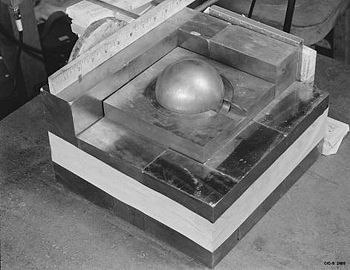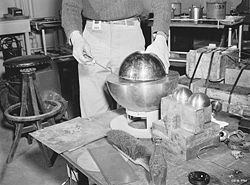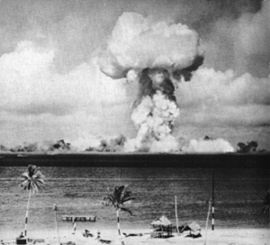
Demon core
Encyclopedia
The Demon core was the nickname given to a 6.2 kilograms (13.7 lb) subcritical mass
of plutonium
that accidentally
went briefly critical in two separate accidents at the Los Alamos laboratory
in 1945 and 1946. Each incident resulted in the acute radiation poisoning
and subsequent death of a scientist. After these incidents, the sphere of plutonium was referred to as the Demon Core.
The core was used in an atomic bomb test in 1946, five weeks after the second fatal accident, and proved in practice to have a slightly increased yield over similar cores which had not been subjected to criticality excursions.
 On August 21, 1945, the plutonium core produced a burst of neutron radiation
On August 21, 1945, the plutonium core produced a burst of neutron radiation
that caught Harry Daghlian
in its path. Daghlian was a physicist who made a mistake while working alone performing neutron reflection
experiments on the core. The core was placed within a stack of neutron-reflective tungsten carbide
bricks, and the addition of each brick moved the assembly closer to criticality. While attempting to stack another brick around the assembly Daghlian accidentally dropped it onto the core and thereby caused the core to go critical. Despite quick action in moving the brick off the assembly, Daghlian received a fatal dose of radiation. He died 25 days later from acute radiation poisoning
.
Another person who was in the lab at the time of the accident—Private Robert J. Hemmerly, a Special Engineer Detachment (SED) guard—received an exposure of approximately 31 roentgens of soft X-rays (80 kV equivalent) and less than 1 roentgen of gamma rays. Hemmerly died in 1978 (33 years after the accident) from acute myelogenous leukemia at the age of 62.
 On May 21, 1946, physicist Louis Slotin
On May 21, 1946, physicist Louis Slotin
and seven other scientists were in a Los Alamos laboratory conducting an experiment to verify the exact point at which a subcritical mass (core) of fissile material could be made critical by the positioning of neutron reflectors. The test was known as "tickling the dragon's tail" for its extreme risk. It required the operator to place two half-spheres of beryllium
(a neutron reflector) around the core to be tested and manually lower the top reflector over the core via a thumb hole on the top. As the reflectors were manually moved closer and farther away from each other, scintillation counters measured the relative activity from the core. Allowing them to close completely would result in the instantaneous formation of a critical mass and a lethal power excursion. Under Slotin's unapproved protocol, the only thing preventing this was the blade of a standard flathead screwdriver
, manipulated by the scientist's other hand. Slotin, who was given to bravado, became the local expert, performing the test almost a dozen separate times, often in his trademark bluejeans and cowboy boots, in front of a roomful of observers. Enrico Fermi
reportedly told Slotin and others they would be "dead within a year" if they continued performing it.
While lowering the top reflector, Slotin's screwdriver slipped a fraction of an inch, allowing the top reflector to fall into place around the core. Instantly there was a flash of blue light and a wave of heat across Slotin's skin; the core had become supercritical
, releasing a massive burst of neutron radiation
. He quickly knocked the two halves apart, stopping the chain reaction and likely saving the lives of the other men in the laboratory. Slotin's body positioning over the apparatus also shielded the others from much of the neutron radiation. He received a lethal dose in under a second and died nine days later from acute radiation poisoning
. The nearest physicist to Slotin, Alvin C. Graves
, was watching over Slotin's shoulder and was thus partially shielded by him, receiving a high but non-lethal radiation dose. Graves was hospitalized for several weeks with severe radiation poisoning, developed chronic neurological and vision problems as a result of the exposure, suffered a significant shortening of his lifespan and died of a radiation-induced heart attack 20 years later. The other six people in the room were far enough away from the assembly to avoid fatal injury, but they all suffered other complications as a result of the accident. Two people suffered severe shortening of their lives and died years later from radiation induced complications: leukemia (at age 42, 18 years after the accident) and clinical aplastic anemia
.
 The Demon core was put to use for the Able detonation test of the Crossroads
The Demon core was put to use for the Able detonation test of the Crossroads
series on July 1, 1946, demonstrating that the criticality experiments of Daghlian and Slotin increased the efficiency of the weapon.
refers to the Daghlian incident in his novel The Atrocity Archives
, specifically in the included short novel by similar title.
The 1989 film Fat Man and Little Boy
portrays, in a character named Michael Merriman (played by John Cusack
), a fictional composite of Harry K. Daghlian and Louis Slotin. The character dies of radiation poisoning after two hemispheres of fissile material, which are separated by a screwdriver, connect accidentally.
Joseph Kanon
recounts events surrounding the first criticality accident, "Tickling the tail of the sleeping dragon [...] Testing how far we can go," in his 1997 novel Los Alamos.
Critical mass
A critical mass is the smallest amount of fissile material needed for a sustained nuclear chain reaction. The critical mass of a fissionable material depends upon its nuclear properties A critical mass is the smallest amount of fissile material needed for a sustained nuclear chain reaction. The...
of plutonium
Plutonium
Plutonium is a transuranic radioactive chemical element with the chemical symbol Pu and atomic number 94. It is an actinide metal of silvery-gray appearance that tarnishes when exposed to air, forming a dull coating when oxidized. The element normally exhibits six allotropes and four oxidation...
that accidentally
Criticality accident
A criticality accident, sometimes referred to as an excursion or a power excursion, is an accidental increase of nuclear chain reactions in a fissile material, such as enriched uranium or plutonium...
went briefly critical in two separate accidents at the Los Alamos laboratory
Los Alamos National Laboratory
Los Alamos National Laboratory is a United States Department of Energy national laboratory, managed and operated by Los Alamos National Security , located in Los Alamos, New Mexico...
in 1945 and 1946. Each incident resulted in the acute radiation poisoning
Radiation poisoning
Acute radiation syndrome also known as radiation poisoning, radiation sickness or radiation toxicity, is a constellation of health effects which occur within several months of exposure to high amounts of ionizing radiation...
and subsequent death of a scientist. After these incidents, the sphere of plutonium was referred to as the Demon Core.
The core was used in an atomic bomb test in 1946, five weeks after the second fatal accident, and proved in practice to have a slightly increased yield over similar cores which had not been subjected to criticality excursions.
First incident

Neutron radiation
Neutron radiation is a kind of ionizing radiation which consists of free neutrons. A result of nuclear fission or nuclear fusion, it consists of the release of free neutrons from atoms, and these free neutrons react with nuclei of other atoms to form new isotopes, which, in turn, may produce...
that caught Harry Daghlian
Harry K. Daghlian, Jr.
Haroutune Krikor Daghlian, Jr. was an Armenian-American physicist with the Manhattan Project who accidentally irradiated himself on August 21, 1945, during a critical mass experiment at the remote Omega Site facility at Los Alamos National Laboratory in New Mexico, resulting in his death 25 days...
in its path. Daghlian was a physicist who made a mistake while working alone performing neutron reflection
Neutron reflector
A neutron reflector is any material that reflects neutrons. This refers to elastic scattering rather than to a specular reflection. The material may be graphite, beryllium, steel, and tungsten carbide, or other materials...
experiments on the core. The core was placed within a stack of neutron-reflective tungsten carbide
Tungsten carbide
Tungsten carbide is an inorganic chemical compound containing equal parts of tungsten and carbon atoms. Colloquially, tungsten carbide is often simply called carbide. In its most basic form, it is a fine gray powder, but it can be pressed and formed into shapes for use in industrial machinery,...
bricks, and the addition of each brick moved the assembly closer to criticality. While attempting to stack another brick around the assembly Daghlian accidentally dropped it onto the core and thereby caused the core to go critical. Despite quick action in moving the brick off the assembly, Daghlian received a fatal dose of radiation. He died 25 days later from acute radiation poisoning
Radiation poisoning
Acute radiation syndrome also known as radiation poisoning, radiation sickness or radiation toxicity, is a constellation of health effects which occur within several months of exposure to high amounts of ionizing radiation...
.
Another person who was in the lab at the time of the accident—Private Robert J. Hemmerly, a Special Engineer Detachment (SED) guard—received an exposure of approximately 31 roentgens of soft X-rays (80 kV equivalent) and less than 1 roentgen of gamma rays. Hemmerly died in 1978 (33 years after the accident) from acute myelogenous leukemia at the age of 62.
Second incident

Louis Slotin
Louis Alexander Slotin was a Canadian physicist and chemist who took part in the Manhattan Project, the secret US program during World War II that developed the atomic bomb....
and seven other scientists were in a Los Alamos laboratory conducting an experiment to verify the exact point at which a subcritical mass (core) of fissile material could be made critical by the positioning of neutron reflectors. The test was known as "tickling the dragon's tail" for its extreme risk. It required the operator to place two half-spheres of beryllium
Beryllium
Beryllium is the chemical element with the symbol Be and atomic number 4. It is a divalent element which occurs naturally only in combination with other elements in minerals. Notable gemstones which contain beryllium include beryl and chrysoberyl...
(a neutron reflector) around the core to be tested and manually lower the top reflector over the core via a thumb hole on the top. As the reflectors were manually moved closer and farther away from each other, scintillation counters measured the relative activity from the core. Allowing them to close completely would result in the instantaneous formation of a critical mass and a lethal power excursion. Under Slotin's unapproved protocol, the only thing preventing this was the blade of a standard flathead screwdriver
Screwdriver
A screwdriver is a tool for driving screws and often rotating other machine elements with the mating drive system. The screwdriver is made up of a head or tip, which engages with a screw, a mechanism to apply torque by rotating the tip, and some way to position and support the screwdriver...
, manipulated by the scientist's other hand. Slotin, who was given to bravado, became the local expert, performing the test almost a dozen separate times, often in his trademark bluejeans and cowboy boots, in front of a roomful of observers. Enrico Fermi
Enrico Fermi
Enrico Fermi was an Italian-born, naturalized American physicist particularly known for his work on the development of the first nuclear reactor, Chicago Pile-1, and for his contributions to the development of quantum theory, nuclear and particle physics, and statistical mechanics...
reportedly told Slotin and others they would be "dead within a year" if they continued performing it.
While lowering the top reflector, Slotin's screwdriver slipped a fraction of an inch, allowing the top reflector to fall into place around the core. Instantly there was a flash of blue light and a wave of heat across Slotin's skin; the core had become supercritical
Critical mass
A critical mass is the smallest amount of fissile material needed for a sustained nuclear chain reaction. The critical mass of a fissionable material depends upon its nuclear properties A critical mass is the smallest amount of fissile material needed for a sustained nuclear chain reaction. The...
, releasing a massive burst of neutron radiation
Neutron radiation
Neutron radiation is a kind of ionizing radiation which consists of free neutrons. A result of nuclear fission or nuclear fusion, it consists of the release of free neutrons from atoms, and these free neutrons react with nuclei of other atoms to form new isotopes, which, in turn, may produce...
. He quickly knocked the two halves apart, stopping the chain reaction and likely saving the lives of the other men in the laboratory. Slotin's body positioning over the apparatus also shielded the others from much of the neutron radiation. He received a lethal dose in under a second and died nine days later from acute radiation poisoning
Radiation poisoning
Acute radiation syndrome also known as radiation poisoning, radiation sickness or radiation toxicity, is a constellation of health effects which occur within several months of exposure to high amounts of ionizing radiation...
. The nearest physicist to Slotin, Alvin C. Graves
Alvin C. Graves
Alvin C. Graves was an atomic physicist and director of U.S. nuclear weapons testing for many years.Graves was born in 1909 in Washington, DC, the youngest of six children. He graduated at the top of his class from the University of Virginia in 1931 with a bachelors degree in electrical...
, was watching over Slotin's shoulder and was thus partially shielded by him, receiving a high but non-lethal radiation dose. Graves was hospitalized for several weeks with severe radiation poisoning, developed chronic neurological and vision problems as a result of the exposure, suffered a significant shortening of his lifespan and died of a radiation-induced heart attack 20 years later. The other six people in the room were far enough away from the assembly to avoid fatal injury, but they all suffered other complications as a result of the accident. Two people suffered severe shortening of their lives and died years later from radiation induced complications: leukemia (at age 42, 18 years after the accident) and clinical aplastic anemia
Aplastic anemia
Aplastic anemia is a condition where bone marrow does not produce sufficient new cells to replenish blood cells. The condition, per its name, involves both aplasia and anemia...
.
Demon core in use

Operation Crossroads
Operation Crossroads was a series of nuclear weapon tests conducted by the United States at Bikini Atoll in mid-1946. It was the first test of a nuclear weapon after the Trinity nuclear test in July 1945...
series on July 1, 1946, demonstrating that the criticality experiments of Daghlian and Slotin increased the efficiency of the weapon.
Cultural references
Charles StrossCharles Stross
Charles David George "Charlie" Stross is a British writer of science fiction, Lovecraftian horror and fantasy. He was born in Leeds.Stross specialises in hard science fiction and space opera...
refers to the Daghlian incident in his novel The Atrocity Archives
The Atrocity Archives
The Atrocity Archives contains two stories by British author Charles Stross, consisting of the short novel The Atrocity Archive and The Concrete Jungle, which won the 2005 Hugo Award for Best Novella.The stories are Lovecraftian spy thrillers involving a secret history of the 20th century,...
, specifically in the included short novel by similar title.
The 1989 film Fat Man and Little Boy
Fat Man and Little Boy
Fat Man and Little Boy is a 1989 film that reenacts the Manhattan Project, the secret Allied endeavor to develop the first nuclear weapons during World War II. The film is named after the nuclear weapons known by the code names "Fat Man" and "Little Boy". The code names can be taken for joking...
portrays, in a character named Michael Merriman (played by John Cusack
John Cusack
John Paul Cusack is an American film actor and screenwriter. He has appeared in more than 50 films, including The Journey of Natty Gann, Say Anything..., Grosse Point Blank, The Thin Red Line, Stand by Me, Con Air, Being John Malkovich, High Fidelity, Serendipity, Runaway Jury, The Ice Harvest,...
), a fictional composite of Harry K. Daghlian and Louis Slotin. The character dies of radiation poisoning after two hemispheres of fissile material, which are separated by a screwdriver, connect accidentally.
Joseph Kanon
Joseph Kanon
Joseph Kanon is an American author, best known for thriller and spy novels set in the period immediately after World War II.-Biography:...
recounts events surrounding the first criticality accident, "Tickling the tail of the sleeping dragon [...] Testing how far we can go," in his 1997 novel Los Alamos.
See also
- Nuclear and radiation accidentsNuclear and radiation accidentsA nuclear and radiation accident is defined by the International Atomic Energy Agency as "an event that has led to significant consequences to people, the environment or the facility...
- Nuclear criticality safetyNuclear Criticality SafetyNuclear criticality safety is a field of nuclear engineering dedicated to the prevention of nuclear and radiation accidents resulting from an inadvertent, self-sustaining nuclear chain reaction. Additionally, nuclear criticality safety is concerned with mitigating the consequences of a nuclear...
- Criticality accidentCriticality accidentA criticality accident, sometimes referred to as an excursion or a power excursion, is an accidental increase of nuclear chain reactions in a fissile material, such as enriched uranium or plutonium...
External links
- McLaughlin et al. "A Review of Criticality Accidents" by Los Alamos National LaboratoryLos Alamos National LaboratoryLos Alamos National Laboratory is a United States Department of Energy national laboratory, managed and operated by Los Alamos National Security , located in Los Alamos, New Mexico...
(Report LA-13638), May 2000.

